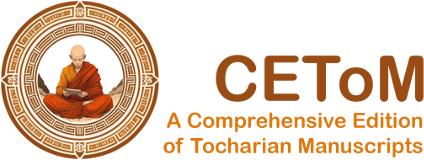W 19
| Known as: | W 19; Or 6402A 1.7 |
|---|---|
| Cite this page as: | Adrian Musitz. "W 19". In A Comprehensive Edition of Tocharian Manuscripts (CEToM). Created and maintained by Melanie Malzahn, Martin Braun, Hannes A. Fellner, and Bernhard Koller. https://cetom.univie.ac.at/?m-or6402a17 (accessed 08 Jul. 2025). |
Edition | |
| Editor: | Adrian Musitz |
Provenience | |
| Collection: | British Library (London) |
Language and Script | |
| Language: | TB |
Object | |
| Material: | ink on paper |
| Form: | Poṭhī |
Images
Images from idp.bl.uk by courtesy of the International Dunhuang Project and the British Library.
Transliteration
| a1 | /// |
|---|---|
| a2 | /// • ·[ra] – – – /// |
| a3 | – – [a] ·[l]· ○ we ta • kha dī ra • ta ma – – – – – – – – |
| a4 | ·ai le ya¯ ¯k• ni ○ lu tpā¯ ¯l• pra pu nta ri¯ ¯k• [śi] ri – – ·pa • nā [ga] [pa] |
| a5 | – – ·au – – śk· • cau tā nä • ha ri da • i ñcu wa • – – – tra phā¯ ¯l |
| a6 | kuśa n[ā]¯ ¯r ṣe me – – ·[e] [w]ī ye kwä ñc[ī] ta [ṣṣe] [ṣa] lype – – me – – |
| b1 | – [rsa] pa kṣa lle • || ka ru ṇa [sā] ri • [pu] – – – – – tra phā¯ ¯l• • – lu – [¯l] |
| b2 | – [ssau] • [śkwa] [śko] – cau [tā]ṃ • pi pi ta [ka] ma [tyä] • ku rka ma ṣṣi ptsā¯ ¯ñä – mā – |
| b3 | [pa] [tra] • ṣe ○ me yä¯ ¯rm• ke wī ye ku ñcī ta ṣṣe ṣa lype – ma l··e |
| b4 | – – k· ·le • ○ se ṣa lype a ca la su [tta] [rai] [ñe] • || – – – – |
| b5 | /// – r[ka] ma ṣṣi [ptsā] [ñä] /// |
| b6 | /// ·i • pi ·au |
Transcription
| a1 | /// |
|---|---|
| a2 | /// • (p)rä(śnavarṇi) /// |
| a3 | – – a ·l· wetä • khadīrä • tama(lapāträ) – – – – – |
| a4 | n1 (ś)aileyak nilutpāl prapuntarik śiri(ṣapuṣ)pä • nāgapa |
| a5 | – ·au – – śk(o) • cautānä • harida • iñcuwa • – – – träphāl |
| a6 | kuśanār ṣeme (yärm) (k)ewīye kwäñcītäṣṣe ṣalype – (ṣe)me – (ma)¬ |
| b1 | (lkwe)rsa päkṣalle • ॥ karuṇasāri • pu(narnap) (metä) träphāl • (ni)lu(tpā)l |
| b2 | n2 (pi)ssau • śkwaśko (•) cautāṃ • pipitakamatyä • kurkamäṣṣi ptsāñ (ta)mā(la)¬ |
| b3 | paträ • ṣeme yärm kewīye kuñcītäṣṣe ṣalype – mal(kw)e¬ |
| b4 | (rsa)n3 (pä)k(ṣal)le • se ṣalype acalasuttaraiñe • ॥ – – – – |
| b5 | /// (ku)rkamäṣṣi ptsāñä /// |
| b6 | /// ·i • pi ·au |
Translation
| b1 | est à cuire avec du lait || Dalbergia sisu (?), Boerhaavia diffusa, Gymnema aurantiacum, les trois myrobolans, lotus bleu; |
|---|---|
| b2 | aneth, ..., miel, délayage de blé, stigmates de safran, pat- |
| b3 | -chouli, une mesure (d’urine) de vache, huile de sésame avec du lait |
| b4 | á cuire; cette huile ... || ... |
| b5 | ... stigmates de safran ... |
Commentary
Philological commentary
| n1 | It is difficult to say how the Filliozat/Broomhead reading "śarip [mus]t" came about, but it is impossible. The alleged "TA" is obviously a "PA". |
|---|---|
| n2 | pipitakamatyä is completely unclear. Filliozat/Broomhead have piṣitakamanthä, which Filliozat translates as "délayage de blé". However, the last akṣara here certainly is not a nthä. Also, the "ṣi" looks exactly like the previous pi. However, in W 36 a4, it is indeed written as piṣita. piṣitaka also doesn't really seem to occur anywhere in Sanskrit/Prakrit texts. |
| n3 | The reading of acalasuttaraiñe is tentative. There doesn't appear to be a word attested in Sanskrit/Prakrit that starts with acalasu-. |
References
Online access
Edition
Filliozat 1948: 71-72, 84; Broomhead 1962: 20
Bibliography
Broomhead, J.W. 1962. “A textual edition of the British Hoernle, Stein and Weber Kuchean manuscripts. With transliteration, translation, grammatical commentary and vocabulary. I = Edition.” PhD, Cambridge: Trinity College.
Filliozat, Jean. 1948. Fragments de textes koutchéens de médecine et de magie. Texte, parallèles sanskrits et tibétains, traduction et glossaire. Paris: Librairie d’Amérique et d’Orient Adrien-Maisonneuve.
“The International Dunhuang Project: The Silk Road Online.” n.d. http://idp.bl.uk.




